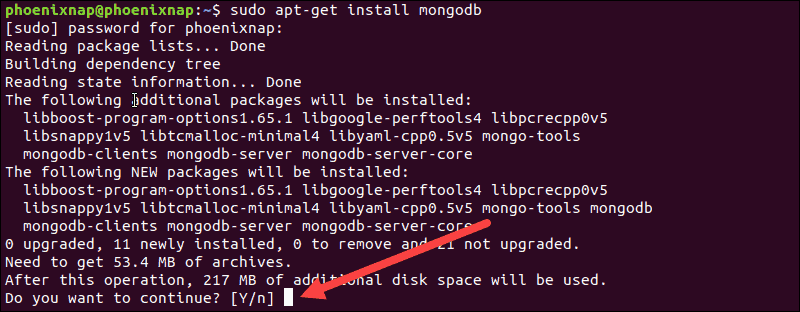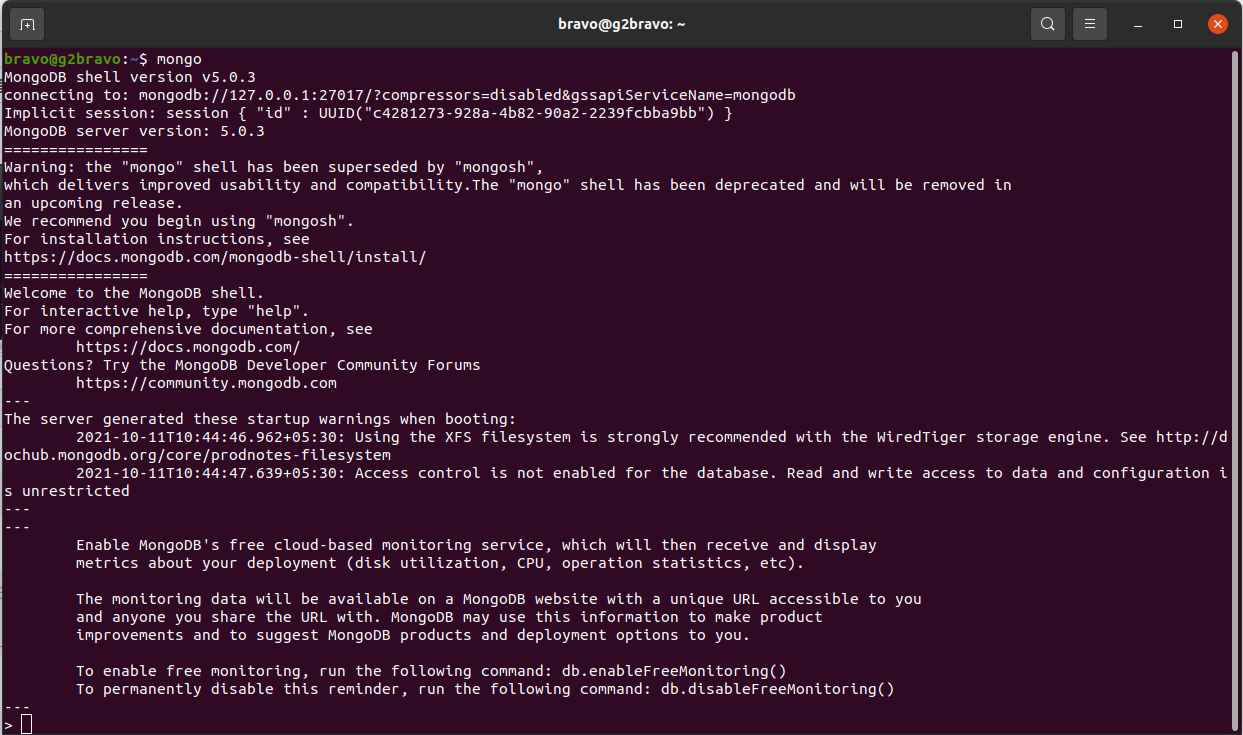
- #INSTALL MONGO SHELL ONLY ON UBUNTU INSTALL#
- #INSTALL MONGO SHELL ONLY ON UBUNTU UPDATE#
- #INSTALL MONGO SHELL ONLY ON UBUNTU MANUAL#
- #INSTALL MONGO SHELL ONLY ON UBUNTU UPGRADE#
sudo apt updateĪdd the MongoDB’s official repository to the system. You should always use the official MongoDB packages. MongoDB packages available in MongoDB repository are generally fresher than those in the Ubuntu repositories. MongoDB Inc releases stable packages for Ubuntu operating systems and shares them via their repository. Let’s check the contents of that file: sudo cat /var/log/mongodb/mongod.CentOS 8 CentOS 7 CentOS 6 Debian 10 Debian 9 Ubuntu 18.04/16.04 Add MongoDB Repository This information is stored (by default) at /var/log/mongodb/mongod.log. Now you should verify that the mongod process started successfully. To start the mongodb daemon mongod, type: sudo service mongod start The settings in /etc/nf are applied when starting/restarting the mongodb service instance.
#INSTALL MONGO SHELL ONLY ON UBUNTU MANUAL#
You can check out the manual for detailed information. I won’t go into changing these default settings since that is beyond the scope of this guide. You have now successfully installed MongoDB! Configuring MongoDBīy default, the package manager will create /var/lib/ mongodb and /var/log/ mongodb and MongoDB will run using the mongodb user account. To stop that from happening (and freezing to the installed version), use: echo "mongodb-org hold" | sudo dpkg -set-selectionsĮcho "mongodb-org-server hold" | sudo dpkg -set-selectionsĮcho "mongodb-org-shell hold" | sudo dpkg -set-selectionsĮcho "mongodb-org-mongos hold" | sudo dpkg -set-selectionsĮcho "mongodb-org-tools hold" | sudo dpkg -set-selections If you only change it in the mongodb-org=4.0.6 part, the latest version will be installed.īy default, when updating using the package manager ( apt-get), MongoDB will be updated to the newest updated version.
#INSTALL MONGO SHELL ONLY ON UBUNTU INSTALL#
If you choose to install a specific version, make sure you change the version number everywhere. Or a specific version (change the version number after equal sign) sudo apt install -y mongodb-org=4.0.6 mongodb-org-server=4.0.6 mongodb-org-shell=4.0.6 mongodb-org-mongos=4.0.6 mongodb-org-tools=4.0.6 Now you can ether install the latest stable version of MongoDB: sudo apt install -y mongodb-org
#INSTALL MONGO SHELL ONLY ON UBUNTU UPDATE#
To be able to install mongodb-org, we’ll have to update our package database so that your system is aware of the new packages available: sudo apt update Now, you need to add a new repository in your sources list so that you can install MongoDB Community Edition and also get automatic updates: echo "deb $(lsb_release -cs)/mongodb-org/4.0 multiverse" | sudo tee /etc/apt//mongodb-org-4.0.list Let’s get to it!įirst, we’ll have to import the public key: sudo apt-key adv -keyserver hkp://:80 -recv 9DA31620334BD75D9DCB49F368818C72E52529D4 Make sure mongodb is not installed on your system before applying this steps. is called mongodb-org, not mongodb (this is the name of the package in the Ubuntu Repository). You’ll have to type a few more commands and it might be intimidating if you are newer to the Linux world.īut there’s nothing to be afraid of! We’ll go through the installation process step by step. This is the way the recommended way to install MongoDB, using the package manager. Install MongoDB Community Edition on Ubuntu


Make sure to backup any collections or documents you might want to keep since they will be wiped out! Method 2. This should completely get rid of your MongoDB install. If you installed MongoDB from the Ubuntu Repository and want to uninstall it (maybe to install using the officially supported way), type: sudo systemctl stop mongodb That’s unfortunately more involved than what I can cover here and depends on your configuration. Note: Depending on how you plan to use MongoDB, you might need to adjust your Firewall. Please check out the manual for detailed information on the available queries and options. To start working with (creating and editing) databases, type: mongo You can also change if MongoDB automatically starts when the system starts up ( default: enabled): sudo systemctl disable mongodb MongoDB is currently a systemd service, so we’ll use systemctl to check and modify it’s state, using the following commands: sudo systemctl status mongodb The MongoDB service should automatically be started on install, but to check the status type sudo systemctl status mongodb That’s it! MongoDB is now installed on your machine. Go ahead and install MongoDB with: sudo apt install mongodb
#INSTALL MONGO SHELL ONLY ON UBUNTU UPGRADE#
Open up a terminal and type: sudo apt update & sudo apt upgrade -y

Installing MongoDBįirst, make sure your packages are up-to-date. This is the easy way to install MongoDB on your system, you only need to type in a simple command.


 0 kommentar(er)
0 kommentar(er)
